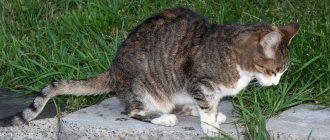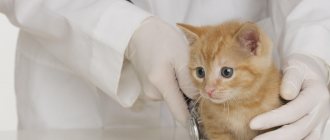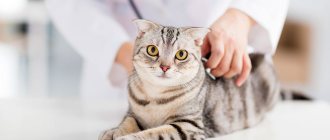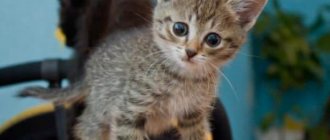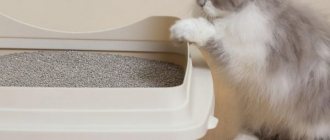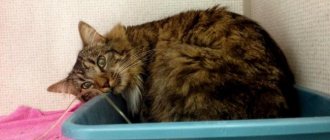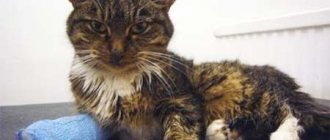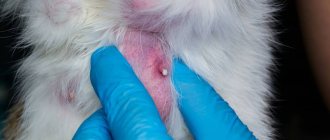Veronica Igorevna Sharipova
veterinarian Petstory
Feline pancreatitis as an independent disease is a fairly rare pathology. Oddly enough, there are many myths and prejudices around this disease. For example, it is believed that if a cat has acute or chronic vomiting, then he has pancreatitis and needs a low-fat diet. But this is not at all true. We will look at the features of pancreatic inflammation in cats in this article.
The pancreas is a unique organ in the body, which is a gland of both exogenous and endogenous secretion. The exocrine function ensures optimal digestion of food and absorption of nutrients in the intestine and consists of the production of special digestive enzymes (trypsin, lipase, amylase). The endocrine function of the pancreas is to maintain glucose levels in the body and is ensured by the production of the hormone insulin. Thus, inflammation of the pancreas - pancreatitis - is a dangerous disease that affects the functioning of the entire body.
According to a new large study conducted on 6504 cats, it was found that only in 0.6% of cases the death of cats was caused by pancreatitis, and in 0.4% of cases the disorders were characteristic of chronic pancreatitis, and in 0.2% of cases - for acute. Thus, the rare intravital diagnosis of this disease is associated with difficulties in making a diagnosis and a fairly rapid fatal outcome for the pet.
Causes of the disease
The main functions of the pancreas are the supply of digestive enzymes to the small intestine, which break down proteins, fats and carbohydrates entering the body. But at the same time, the gland also produces special substances - inhibitors of proteolytic enzymes, which protect the organ from self-digestion. Under certain conditions, the production of these substances can be disrupted, causing the activation of digestive enzymes stored in the cells of the pancreas, and they damage the organ, leading to the disease - pancreatitis.
The exact causes of pancreatitis in cats are not well understood. In most confirmed cases of the disease, the leading factor in the onset of the disease remains unknown. It is believed that in cats the development of pancreatitis can be provoked by such complex disorders of the body as:
- parasitic diseases (fascioliasis);
- secondary pancreatitis as a complication of bacterial infection;
- traumatic damage to an organ (for example, as a result of a fall from a height);
- obstruction of the pancreatic duct;
- various diseases accompanied by increased calcium levels in the blood (hypercalcemia);
- chronic kidney disease;
- immune-mediated disease;
- organophosphate poisoning;
- idiopathic causes;
- as well as some infectious diseases (toxoplasmosis, calicivirus, infectious peritonitis cause so-called viral pancreatitis in cats).
In most cases, the causes that trigger pancreatitis are not obvious. Pancreatitis rarely occurs as an independent disease; it is usually accompanied by inflammation of the small intestine and liver disease. This complex of diseases is known as “feline triaditis.”
Acute pancreatitis often becomes chronic, which, in turn, can lead to the development of a disease such as exocrine pancreatic insufficiency. With the development of purulent inflammation of the organ, the prognosis of the disease is poor.
There is no sex or age predisposition to feline pancreatitis. Even a kitten can have pancreatitis.
The role of the pancreas in the animal body
The pancreas in cats is an organ of the digestive system that performs endocrine and exocrine functions.
Endocrine functions are expressed in the synthesis of hormones that regulate carbohydrate metabolism by increasing or decreasing the concentration of glucose in the blood and tissues. These hormones include insulin and glucagon.
The exocrine function is to produce pancreatic juice, which contains enzymes for the digestion of proteins, lipids and carbohydrates.
During normal functioning of the organ in cats, the secretion of the pancreas is secreted into the duodenum, where it acts on the food bolus that comes from the stomach. However, when the gland ducts are blocked as a result of inflammation, tumor or other factors, active enzymes begin to digest their own tissues. Involvement of pathogenic microflora in the pathological process quickly leads to the development of sepsis, which causes death in cats.
Symptoms of pancreatitis in cats
Contrary to popular belief, vomiting is not a symptom of pancreatitis in cats. This disease in cats, in principle, does not have a specific manifestation, and in most cases, the presence of pancreatitis in a cat becomes known only after going to the clinic and undergoing a medical examination. Often the only sign of pancreatitis in a cat may be weight loss and/or refusal to eat.
You can also identify episodes of lethargy, an increase in temperature or, conversely, a decrease in temperature; pain in the abdominal area is often detected. In rare cases, cats may have icteric mucous membranes (i.e., jaundice), loose stools, and even a palpable mass in the abdominal cavity.
Remember that when the first symptoms of pancreatitis appear in a cat, treatment should be started immediately by contacting a veterinarian!
Complications and consequences
High mortality in the acute form is associated with early complications arising from the inflammatory process. It leads to thrombosis, internal bleeding, liver and respiratory failure.
With a prolonged course of the disease, the likelihood of developing oncology and the appearance of fistulas increases. The body's defenses gradually decline, so it becomes vulnerable to pathogenic microorganisms. In the event of a secondary infection, not only the pancreas suffers, but also the nearby intestines and other neighboring tissues. This leads to purulent abscesses, fraught with the appearance of sepsis. With this outcome, the animal may die from blood poisoning.
Another dangerous complication is pancreatic necrosis. This pathology is accompanied by the death of tissue of the affected organ and loss of its functionality. Enzymes and breakdown products entering the bloodstream aggravate intoxication. Not only the immediate organs are in danger, but also the heart and brain. In 90% of cases, pancreatic necrosis is incurable.
With late treatment, the acute form develops into a chronic form. Like pancreatic necrosis, it is incurable. Treatment is based on symptomatic therapy, lifelong diet and regular prevention.
Forms of feline pancreatitis
In modern gastroenterology, depending on the degree of reversibility of changes, pancreatitis is distinguished between acute and chronic. In acute pancreatitis, provided the cause of the disease is eliminated, the inflammation of the organ and all the changes caused by it are completely reversible. In chronic pancreatitis, prolonged inflammation of the organ is observed, followed by the formation of irreversible changes. It is important to understand that making a diagnosis is very difficult and that the final diagnosis can only be established after performing an organ biopsy (taking a piece of the organ for analysis) followed by submitting the material for histology. Unfortunately, based only on history and clinical signs of the disease, it is impossible to distinguish acute pancreatitis from chronic pancreatitis.
Acute form
Acute pancreatitis usually develops rapidly and can be a consequence of organ injury, infection, or poisoning. It is very common for cats to develop traumatic organ damage after falling from a height.
It is worth noting that acute inflammation of the pancreas directly affects the functioning of the liver and intestines. Bacterial microflora from the affected organ enters the duodenum through the common bile duct, from where it then enters both the following parts of the intestine and the liver through the bile ducts. Thus, hepatopathy, hepatitis, and cholangitis may develop.
The prognosis for acute pancreatitis is cautious. There are high risks of developing various systemic complications - pulmonary edema, cardiac arrhythmia, peritonitis, diabetes mellitus, exocrine pancreatic insufficiency. In case of acute pancreatitis in a kitten, the prognosis is usually more favorable due to the high compensatory capabilities of the body.
Chronic form
Chronic pancreatitis is a long-term disease against the background of any irreversible physiological changes. Despite the fact that the initial cause of chronic pancreatitis in most cases cannot be determined, possible risk factors must be eliminated. Therefore, if you suspect chronic pancreatitis in a cat, you must:
- control the animal's diet;
- exclude the presence of possible hidden infectious diseases;
- monitor for the presence of hypercalcemia and treat its causes if detected;
- collect a complete medical history of the patient’s treatment and, if necessary, change treatment;
- Consider the use of immunosuppressive drugs if an autoimmune cause is suspected.
Fertilizers and vitamin supplements
Vitamins for pancreatitis are not always needed; their use depends on the degree of development of the disease, the condition of the pet, and the reasons that caused the pathology. Consult your veterinarian before use. Uncontrolled consumption leads to hypervitaminosis and serious consequences for the body.
Group B
This is a group of vitamins that includes the following substances:
- Thiamine (B1). Water soluble. Preserved in an acidic environment. Responsible for normal carbohydrate, protein and fat metabolism. Also involved in the exchange of water and salts. It plays a special role in the functioning of nerves. When there is a deficiency of thiamine, the animal experiences seizures. The main source is meat, also found in the brain, liver, and heart.
- Riboflavin (B2). Water soluble. It is preserved in an acidic environment, quickly destroyed in alkaline solutions and under the influence of UV rays. Involved in oxidation and reduction. It is necessary for tissue regeneration, immunity, healthy skin and coat. Deficiency manifests itself in the form of photophobia and conjunctivitis. It is found in sufficient quantities in milk, cottage cheese, and kefir.
- Pyridoxine (B6). Water soluble. It is involved in the production of enzymes in the pancreas and is also required for the creation of hemoglobin. Pyridoxine is found in meat foods and dairy products. Deficiency manifests itself in the form of muscle weakness, depression, and poor circulation.
- Cyanocobalamin (B12). Used in the liver in metabolic processes. The vitamin is found in products of animal origin: meat, milk, eggs. Deficiency manifests itself in anemia and neurological disorders.
Vitamin C
Ascorbic acid improves the functioning of the endocrine system and is involved in the metabolism of iron and cholesterol. But its main task is to participate in the synthesis of collagen, therefore, with a deficiency of vitamin C, scurvy occurs. Ascorbic acid is needed for normal hematopoiesis, the formation of vascular walls and cartilage tissue. Good antioxidant. Deficiency of this substance leads to scurvy, inflammation and weakened immunity.
There is a lot of ascorbic acid in pumpkin, currants, and rose hips. It is soluble in water and is well preserved in products. Abuse leads to impaired absorption of vitamin B12, an increase in the concentration of uric acid, and hence the formation of stones. This is especially important to consider in cats, since they are predisposed to KSD.
Vitamin E
Tocopherol is soluble in fats. Therefore, when it is absorbed in the intestines, fat is needed. And since with pancreatitis its amount in the diet is reduced, vitamin E is administered in the form of injections. Tocopherol is useful because it is a strong antioxidant. It is well preserved in products. Also improves digestion and peristalsis. An excellent antioxidant.
It is most often recommended for diabetes. Tocopherol deficiency manifests itself in anemia. It is found in large quantities in spinach, broccoli, and oatmeal. Excess tocopherol is normally excreted in bile. However, with pancreatitis, this regulatory process is sometimes disrupted, which leads to sepsis, ascites, and renal failure.
Vitamin A
Retinol is fat soluble. Therefore, the intestines need fat to absorb it. Since fats are prohibited during pancreatitis, it is advisable to administer vitamin A by injection. It is found in large quantities in pumpkin, carrots, broccoli, meat and fish. Vitamin E is required for normal absorption of retinol.
It disintegrates quite quickly in the fresh air, so it is obtained only from fresh products. It is necessary for oxidation and reduction, normal development of eyes and bones, skin and hair, a healthy immune system, required for protein, carbohydrate, and fat metabolism. Good antioxidant. Hypervitaminosis disrupts the course of pregnancy.
Treatment of pancreatitis in cats
Treatment of pancreatitis in cats consists of medication and diet.
If symptoms of acute pancreatitis are detected in cats, treatment in a hospital setting is indicated. Treatment of acute pancreatitis in cats consists of relieving symptoms and is aimed at maintaining the body’s water and acid-base balance, relieving the inflammatory process and preventing the development of systemic disorders.
First of all, cats are given intravenous therapy: depending on the results of a blood test for gases and electrolytes, glucose, potassium preparations, complex saline solutions and colloids are used. In severe pancreatitis, blood plasma transfusion may be required.
If vomiting is present, treat with antiemetic drugs (eg, metoclopramide or maropitant).
On the first day of your pet’s stay in the hospital, be sure to monitor the water and electrolyte balance, body weight, amount of urine excreted, determine the activity of enzymes, the level of total protein, glucose, the level of urea and creatinine in the blood.
For feline pancreatitis of a lymphocytic nature, treatment consists of prescribing steroid drugs (for example, prednisolone).
Regardless of the presence of signs of pain, prescription painkillers must be administered; in their absence (as a last resort), metamizole sodium or non-steroidal anti-inflammatory drugs (ketoprofen).
Often, empirical antibacterial therapy (cephalosporins) is administered for acute pancreatitis to prevent the development of infectious complications.
As already mentioned, pancreatitis rarely occurs in its pure form in cats. It is usually accompanied by diseases such as inflammatory bowel disease, cholangiohepatitis and nephritis, and hepatic lipidosis is also common. Therefore, treatment should be comprehensive and aimed at eliminating all pathologies present in the cat.
Drug treatment of chronic pancreatitis in cats is usually supportive in nature and consists of eliminating such consequences of pancreatitis as the development of secondary diabetes mellitus or exocrine pancreatic insufficiency. Thus, the treatment strategy for pancreatitis in cats depends on the severity of symptoms and the development of complications.
Prevention
- Follow the vaccination schedule, regularly deworm and do not neglect preventive examinations.
- Strictly adhere to the diet, monitor the quality of food and ready-made commercial feed, and stop attempts at home to “treat” your pet with food from the table.
- Monitor your pet's weight and prevent obesity.
- Strictly adhere to the recommendations of veterinary specialists during treatment of chronic pancreatitis in the acute phase and during remission. Do not replace medications or change dosages of medications.
- Get rid of all poisonous houseplants.
- Place household chemicals out of the reach of cats.
Strict adherence to these simple rules will help your pet stay healthy longer.
Cat food for pancreatitis
With inflammation of the pancreas, especially in acute cases, cats, as a rule, refuse to eat. Fasting is very dangerous for cats - due to their metabolic characteristics, they quickly develop liver lipidosis. Therefore, at the first signs of illness and refusal to eat, the cat should be force-fed as early as possible. It is important to understand that only with timely treatment, relief of symptoms and the prescription of a special diet, it is possible to bring pancreatitis under control. If there is a complete refusal to eat and it is impossible to give the cat food on their own, special tubes are used - a naso-esophageal tube or esophagostomy. Forced (artificial) nutrition is necessary to prevent the development of liver lipidosis, lack of protein and calories, as well as suppression of the immune system.
So, if a cat is diagnosed with pancreatitis, what should you feed it? Cat food for pancreatitis should be easily digestible. It should be noted that people with pancreatitis first of all need to limit fat - this recommendation does not apply to cats, since they are obligate predators and fats are one of their main sources of energy. Therefore, the best food for a cat with pancreatitis will be the most tasty, complete and balanced diet containing a moderate amount of fat (10-12% in terms of dry matter). It is also important to monitor the level of protein in the diet - it should be no more than 16% of dry matter, since excess protein in the diet stimulates the function of the pancreas, which has a negative effect on pancreatitis in a cat.
If you choose from industrial feeds, you must choose from diets intended for the treatment of diseases of the gastrointestinal tract, diabetes, hypoallergenic feeds based on protein hydrolyzate are also suitable (especially in cases where pancreatitis is accompanied by inflammatory bowel disease). It should be noted that if a kitten has pancreatitis, special attention should be paid to the level of calcium and protein in the diet due to the increased needs of the growing body.
When feeding a cat at home with pancreatitis, you must pay attention to special additives: antioxidants, fatty acids, cobalamin and vitamin K. It should be noted that you can feed a cat with pancreatitis with homemade diets, but for this you must definitely contact a professional veterinary nutritionist. You can even do this online - in the Petstory mobile application you can sign up for an online consultation with a nutritionist. You can download the application from the link.
Medical nutrition
After diagnosis and all therapeutic measures, sick cats are prescribed a therapeutic diet.
In the first days after therapeutic fasting, only liquid mucous porridges with water are allowed: Hercules, buckwheat, rice. Gradually, it is allowed to supplement the diet with steamed egg white omelettes, vegetable purees (zucchini, carrots) and low-fat lactic acid products (yogurt, kefir and cottage cheese). The food should be warm. Give it in small portions 5-6 times a day.
Industrial feed
Animals that are accustomed to dry food are prescribed medicinal food of the “super-premium” and “holistic” classes for life.
Their formulas consist of easily digestible ingredients and contain moderate amounts of fat and protein.
Medicinal foods for pancreatitis:
- Royal Canin Gastro Intestinal Moderate Calorie;
- Hill's i/d;
- Eukanuba Intestinal;
- Purina EN.
What is prohibited to feed:
- raw vegetables and fruits;
- smoked products;
- whole milk;
- fatty meats and fish;
- canned food, salty foods;
- sweets;
- bakery products;
- strong meat broths;
- fatty fermented milk products;
- cereal products;
- industrial feed of the "economy" class;
- dry food containing corn.
A therapeutic diet promotes a speedy recovery of the animal and prevents relapse.
Diagnostic methods
Diagnosis of pancreatitis is possible only in a specialized clinic; the following methods are used for this:
- Ultrasound of the abdominal organs. Determines swelling of the gland, changes in the echogenic pattern of the affected organ, and inflammatory phenomena.
- Blood tests: clinical and biochemical. They show excess levels of liver enzymes, glucose and bilirubin levels, cholesterol, ALT, alkaline phosphatase. Biochemistry reveals hypocalcemia and hypokalemia. Clinical blood test – non-regenerative anemia.
- Rapid test for pancreatic lipase.
- Biopsy and histopathology are the most informative methods. They make it possible to distinguish the acute form from the chronic one, to detect fibrosis, edematous phenomena, parenchymal tissue necrosis, and ductal hyperplasia.
Please note: due to the difficulty of timely diagnosis, most animals cannot be definitively diagnosed until after necropsy. That’s why it’s so important to be attentive to your pets and show them to veterinarians at the first suspicious symptoms.




